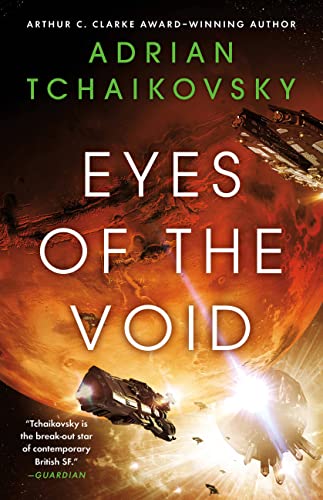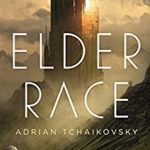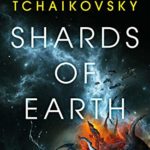I love a space adventure that lures me on with the promise of revealing the fundamental nature of a fictional universe, preferably through a dazzling experience that only the hero has earned the right to have. Well, no one can really explain the nature of everything, at least not very clearly, so far, but Adrian Tchaikovsky brings us marvelously close to feeling we’re right on the brink in Eyes of the Void, second part of The Final Architecture series that began with Shards of Earth.
By the time this series begins, a war has been fought with the Architects, moon-sized entities that destroy any planet they appear over. The war ended when a specially trained and surgically altered intermediary named Idris Telemmier made mental contact with an Architect that somehow caused the invader to disappear. Nevertheless, the great destruction caused by the Architects resulted in the diaspora of humans across space. The giant entities are now back and seem to be breaking the mysterious rules that led them to avoid certain planets in the past. Because Idris is everyone’s best hope to once more save the day, the plot of Eyes of the Void centers on different groups trying to kidnap him and control the use of his powers.
Idris has the specially altered intellect enabling him to navigate and understand unspace, the stratum of the universe – or that thing outside the real – that permits nearly instantaneous space travel. Unspace is also the home of the Architects and the medium through which Idris and a select few others can establish contact with them.
But there is something more that Idris glimpses, the stuff that ties the universe together, as well as a disturbing presence he cannot quite grasp. It is that frightening presence that causes many intermediaries and less highly trained people visiting unspace to tear themselves to pieces out of sheer terror. Idris is compelled to go with anyone anywhere to deepen his contact with unspace and finally grasp the nature of the universe.
Eyes of the Void brings us wild encounters involving a dozen or so species and human variants let loose from Tchaikovsky’s endless imaginarium. Trying to keep or take possession of Idris are the Partheni, human female clone warriors with their own political organization, the human colonies represented at times by a special agent named Havaer, at others by the aristocratic house of Uskari who have trained up a group of outsized super soldiers who can withstand dreadful amounts of pain.
There are also the Essiel, giant beings whose tentacled arms and eye stalks emerge from huge clamshells, the Tothiar, human symbionts with lobster-like creatures attached to their spines that somehow give them fearsome abilities to heal their broken bodies almost instantly, the Naeromathi, elephant-sized beings whose language no other species has ever been able to figure out.
Eyes of the Void follows the main arc of the pursuit of Idris and the search for answers about unspace across four planets of increasingly bizarre and dangerous conditions but also has plenty of time to capture the complex hostilities and rivalries among the species that would be at war if not for the greater threat of the Architects. Tchaikovsky details their encounters in a fairly tongue-in-cheek tone but also provides plenty of insight into the political machinations, trickery and betrayals that motivate them all.
Interestingly, he spends a lot of time sorting through the babel of languages spoken by these species, emphasizing the difficulties of even basic communication. The Essiel wave their arms about and rumble a bit, as translators offer rough ideas of what they might be saying. The leader of the Hiver, a hive mind of roach-like insects assembled in a large frame, also waves arms and buzzes while being translated into nearly Shakespearian sentences that may or may not reflect the right meaning.
And Idris, whose repeated exposure to unspace leaves him physically weakened and confused when he surfaces, usually can’t articulate what he has experienced, even though his mind is crowded with ideas and words. He just can’t get them out, though he does manage to speak a few crucial thoughts and take some action when absolutely necessary. Most of the time he is too frail even to walk and depends for physical protection on his allies, the Partheni warrior Solace, the knife-duelist lawyer, Kris, and the space-barge pilot Olli whose battered body is fitted into a scorpion-like frame.
For all his physical weakness and virtual addiction to unspace, Idris is the character who cares more deeply than anyone else about the human cost of what he does. He sees other humans “leashed” and compelled to undergo the training and surgery as intermediaries that can kill most of them. And he begins to sense the nature of the beings of the Architects, seeing them as controlled by an obscure force to become ever more destructive. He is the one who wants to preserve the creatures of unspace rather than obliterate them as enemies, at least until more is known about their nature.
The Final Architecture series is dense with ideas and adventure and crowded with the wild characters of Tchaikovsky’s incredible and prolific imagination. There are plenty of questions remaining at the end of Eyes of the Void, and I guess I just have to wait another year or so to see how this series answers them. I wish I could plunge into the third book right now.
My thanks to the publisher Orbit and Netgalley for an advance review copy on which to base this review, consisting solely of my own opinions.





Leave a Reply